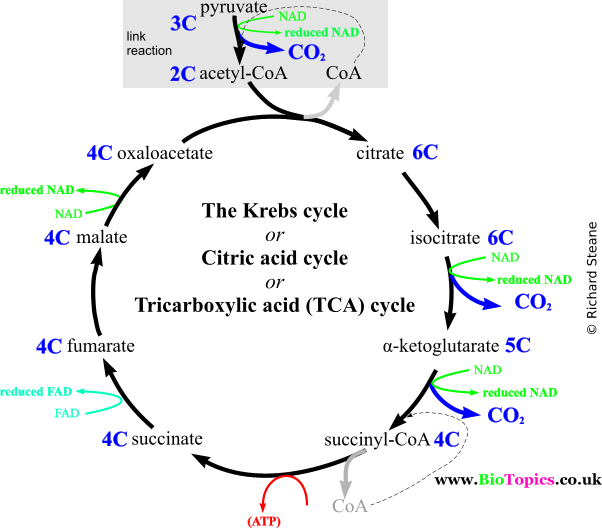After glycolysis, pyruvate enters a mitochondrion.
Here it undergoes a link reaction, losing a carbon atom (as carbon dioxide), and hydrogen (as reduced NAD).
The resulting compound is acetyl coenzyme A.
Acetyl - which some chemists nowadays call ethanoyl - is a fairly simple group containing only 2 carbon atoms: CH3CO- , and coenzyme A merely functions as a carrier - it does not add any more carbon atoms, as it is released to repeat the process.
The link reaction is distinct from glycolysis and the following cycle.
Acetyl - which some chemists nowadays call ethanoyl - is a fairly simple group containing only 2 carbon atoms: CH3CO- , and coenzyme A merely functions as a carrier - it does not add any more carbon atoms, as it is released to repeat the process.
The link reaction is distinct from glycolysis and the following cycle.
The Krebs cycle, also known as the citric acid cycle or the tricarboxylic acid cycle, is a series of oxidation/reduction reactions in which the following transformations occur:
- a 2 carbon compound enters the cycle and combines with a 4 carbon compound, and from this 6 carbon compound citric acid, 2 carbons are removed in separate stages as carbon dioxide (decarboxylation), eventually regenerating the 4 carbon compound so that the cycle can continue
- (pairs of) hydrogen atoms are removed by hydrogen acceptors NAD (x3) and FAD, which are then passed to the hydrogen and electron transport chain to make ATP
- ATP is generated directly as a result of transfer of energy from molecules as they are converted from one form to another

Some important points
Each stage in the cycle (and in the link reaction) occurs twice for every glucose molecule that enters glycolysis, because 2 pyruvate molecules are produced for each glucose.Each stage is controlled by a different enzyme.
Sometimes the intermediate compounds are referred to by the names of their parent acids, e.g. citric acid rather than citrate. Many of these acids have 3 -COOH (carboxylic acid) groups - thus tricarboxylic acids.
The reduced forms of NAD are sometimes written as NADH, NADH2 or NADH/H+, and similarly for reduced FAD.
In the conversion of succinyl coenzyme A to succinate, energy is absorbed by GDP + Pi making GTP, which is passed on to make ATP from ADP +Pi.
This is called substrate level phosphorylation.
The oxygen used in forming carbon dioxide comes from the molecules themselves, not from atmospheric oxygen.
At two stages, coenzyme A (CoA - sometimes written as CoASH) forms an intermediate compound which breaks down and releases it to continue the cycle.
At 2 stages (not shown - formation of isocitrate, and malate) water enters the cycle as a reactant.
Although the Krebs cycle is ofter traced through from carbohydrate metabolism based on glucose as the principal respiratory substrate, other compounds can enter it and be broken down to give energy.
- Fatty acids undergo a breakdown called β-oxidation in which pairs of carbon atoms (etc) are cut off the hydrocarbon section of the R-group (which is usually an even number of C atoms); these are then converted into acetyl coenzyme A.
- Amino acids which are surplus to the body's requirements are deaminated in the liver - the amino group being incorporated into urea - and the resulting keto-acids can enter the Krebs cycle at several points.